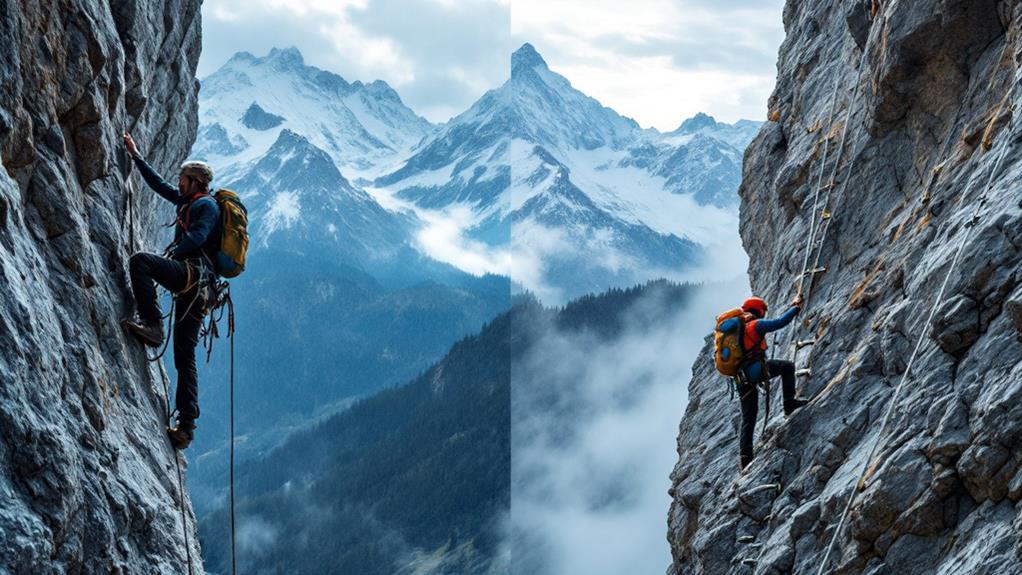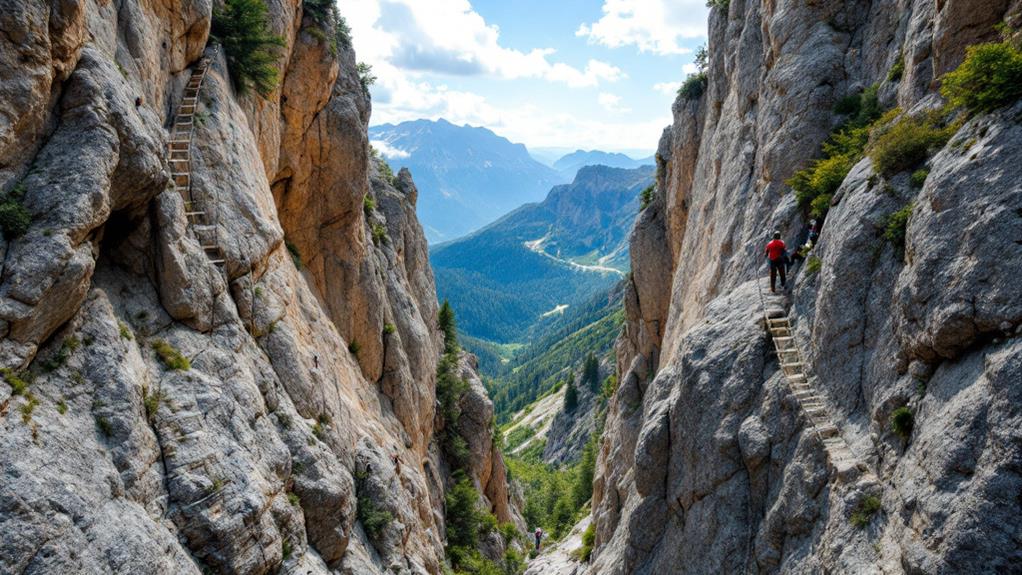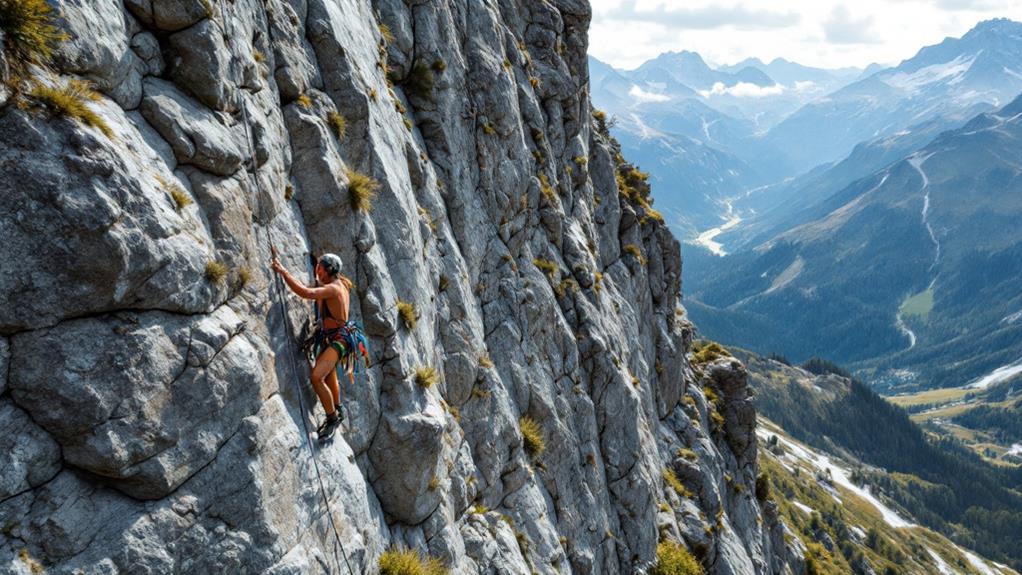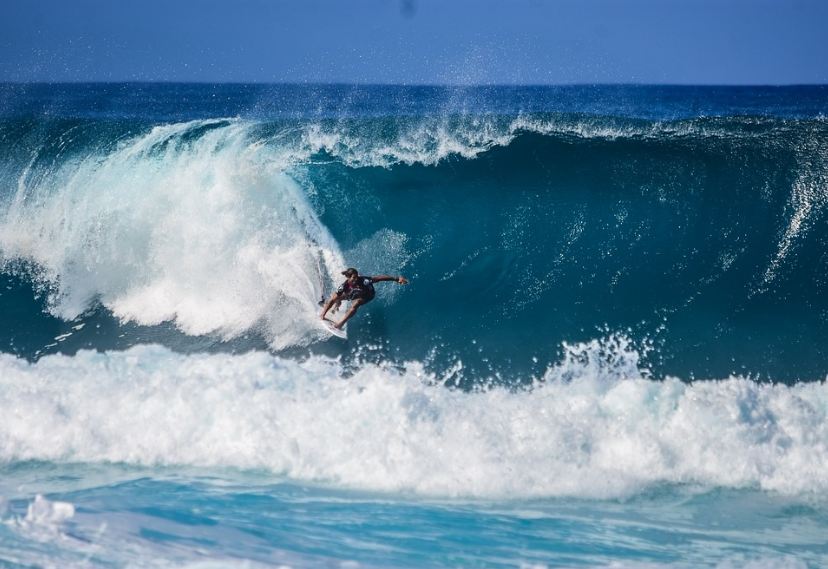What Is the Difference Between Rock Climbing and via Ferrata?

Rock climbing and via ferrata offer distinct vertical adventures. In rock climbing, you'll need diverse gear and advanced skills to navigate natural rock faces. It's physically demanding, requiring strength, flexibility, and problem-solving. Via ferrata, on the other hand, uses fixed metal rungs and cables, making it more accessible for beginners. You'll use specialized equipment and follow pre-established routes. While both activities demand safety awareness, rock climbing involves more complex decision-making and route-finding. Via ferrata routes are often longer but less strenuous. The choice between them depends on your skill level, physical fitness, and desired challenge. Exploring their differences can help you decide which vertical pursuit suits you best.
Equipment and Gear
Safety is paramount in both rock climbing and via ferrata, but the equipment used differs significantly. In rock climbing, you'll need a harness, climbing shoes, helmet, rope, quickdraws, and various types of protection like cams and nuts. You'll also use a belay device and carabiners. Chalk is essential for keeping your hands dry and improving grip. Hang gliders also require a variety of safety equipment to ensure a safe and enjoyable experience.
For via ferrata, you'll still need a harness and helmet, but the rest of the gear is quite different. Instead of a standard climbing rope, you'll use a specialized via ferrata lanyard with two carabiners and an energy-absorbing system. This lanyard attaches you to the fixed steel cable along the route. You'll wear sturdy hiking boots rather than climbing shoes, as you'll be walking and climbing on metal rungs and ladders. Gloves are recommended to protect your hands from the metal cables and rungs.
While both activities require some overlapping gear, via ferrata equipment is generally simpler and more standardized. Rock climbing gear, on the other hand, is more diverse and allows for a wider range of techniques and environments.
Skill Level and Training
While the right equipment is vital for both activities, the skill level and training required for rock climbing and via ferrata differ significantly. Rock climbing demands a higher level of physical fitness, technical skills, and mental fortitude. You'll need to invest considerable time in learning proper climbing techniques, route reading, and safety procedures.
Via ferrata, on the other hand, is more accessible to beginners. You'll still need basic fitness and a head for heights, but the fixed protection systems make it easier to navigate challenging terrain. However, don't underestimate the importance of proper training for via ferrata, as you'll need to understand how to use the equipment correctly and manage potential risks.
| Skill/Training | Rock Climbing | Via Ferrata |
|---|---|---|
| Physical Fitness | High | Moderate |
| Technical Skills | Advanced | Basic |
| Mental Fortitude | Significant | Moderate |
| Learning Curve | Steep | Gentle |
When deciding between rock climbing and via ferrata, consider your current fitness level, willingness to invest in training, and personal goals. Rock climbing offers a more challenging and rewarding experience for those willing to put in the effort, while via ferrata provides a thrilling adventure with a lower barrier to entry.
Safety Measures

Throughout your adventures, prioritizing safety is crucial in both rock climbing and via ferrata. In rock climbing, you'll rely on ropes, harnesses, helmets, and climbing shoes. You'll need to learn proper belaying techniques and how to use protection devices like cams and nuts. It's essential to check your equipment regularly and understand how to tie safe knots. The health benefits of extreme sports can be a motivating factor, but safety must remain the top priority.
Via ferrata, on the other hand, offers a different safety approach. You'll use a specialized via ferrata kit, which includes a harness, helmet, and a lanyard with two carabiners. These carabiners clip onto fixed steel cables along the route, ensuring you're always attached to the mountain. While this system provides more consistent protection, you must learn how to properly use the kit and navigate the fixed elements.
Both activities require vigilance and awareness of your surroundings. In rock climbing, you'll need to assess rock quality and potential hazards. For via ferrata, you'll watch for loose hardware or damaged cables. Learning to take risks and overcome fears is part of the appeal, but you must do so responsibly. Weather conditions affect both activities, so you'll need to monitor forecasts and be prepared to abort if conditions deteriorate.
Physical Demands
Rock climbing and via ferrata will challenge your body in different ways. In rock climbing, you'll engage your entire body, relying heavily on your upper body strength, finger grip, and core muscles. You'll need to support your weight as you navigate vertical surfaces, often making dynamic moves and maintaining balance in precarious positions. This demands excellent flexibility, endurance, and problem-solving skills.
Via ferrata, while still physically demanding, is generally less strenuous. You'll use a combination of climbing and hiking techniques, with the aid of fixed ladders, cables, and bridges. Your legs will do most of the work, but you'll still need upper body strength to pull yourself up on ladders and along cables. The physical challenge often comes from the duration of the route and exposure to height, rather than the technical difficulty of the moves.
Both activities require cardiovascular fitness, but rock climbing tends to be more intense in shorter bursts. Via ferrata routes are usually longer, demanding sustained effort over several hours. You'll need good stamina and mental focus for both, as fatigue can set in during extended climbs or traverses.
Route Types and Terrain

Two key differences between rock climbing and via ferrata lie in their route types and terrain. In rock climbing, you'll encounter natural rock faces with varying degrees of difficulty, from smooth slabs to overhanging cliffs. You'll need to find your own path, using natural features like cracks, ledges, and pockets. Via ferrata routes, on the other hand, are pre-set paths with artificial aids installed on the rock face.
The terrain for rock climbing is typically more diverse and challenging, requiring you to adapt to different rock types and formations. Via ferrata routes are designed to be more accessible, often following a specific path up a mountain or cliff. Here are four key differences in route types and terrain:
- Rock climbing routes can be single or multi-pitch, while via ferrata routes are usually continuous.
- Via ferrata paths often include ladders, bridges, and platforms, which aren't present in traditional rock climbing.
- Rock climbing routes may require route-finding skills, whereas via ferrata routes are clearly marked.
- The difficulty of rock climbing routes can vary greatly, even within a single climb, while via ferrata routes tend to maintain a more consistent level of difficulty.
Accessibility and Location
When it comes to accessibility and location, via ferrata and rock climbing offer distinct experiences. Via ferrata routes are typically found in mountainous regions, often in popular tourist areas. You'll find them in the European Alps, Dolomites, and increasingly in North America and other parts of the world. These routes are designed to be more accessible to a wider range of people, including those with less climbing experience.
Rock climbing, on the other hand, can be practiced in a variety of locations. You can climb indoors at gyms, outdoors on natural rock formations, or even on artificial walls. The accessibility of rock climbing spots varies widely, from easily reached crags near urban areas to remote wilderness locations that require significant hiking or even mountaineering skills to access.
Via ferrata routes are usually well-marked and maintained, making them easier to locate and follow. In contrast, finding and navigating rock climbing routes often requires more research, planning, and navigation skills. You'll need to consult guidebooks, online resources, or local climbing communities to locate suitable routes and access points for rock climbing adventures.
Mental Challenges

While both activities test your physical limits, the mental challenges of rock climbing and via ferrata differ significantly. Rock climbing demands intense focus, problem-solving skills, and mental resilience. You'll face:
- Route-finding: Deciphering the best path up the rock face
- Fear management: Overcoming anxiety about height and potential falls
- Decision-making: Choosing appropriate holds and movements
- Mental endurance: Maintaining concentration for extended periods
In contrast, via ferrata presents fewer mental hurdles. The fixed route and safety equipment reduce the need for complex problem-solving and risk assessment. However, you'll still encounter some mental challenges, such as managing fear of exposure and heights.
Rock climbing requires you to be constantly engaged, analyzing each move and its consequences. You'll need to trust your abilities and equipment, pushing through moments of doubt and fatigue. Via ferrata, on the other hand, allows for a more relaxed mental state. You can enjoy the scenery and experience without the constant pressure of route-finding and decision-making.
Ultimately, rock climbing offers a more intense mental workout, while via ferrata provides a less mentally demanding adventure. Your choice depends on the level of mental challenge you're seeking in your outdoor pursuits.
Group Dynamics
Exploring group dynamics reveals significant differences between rock climbing and via ferrata experiences. In rock climbing, you'll often find smaller, more intimate groups. You'll need to rely heavily on your climbing partner for belaying, safety checks, and moral support. This creates a strong bond and sense of trust between climbers.
Via ferrata, on the other hand, can accommodate larger groups more easily. You'll often see families, friends, or even tour groups tackling these routes together. The fixed safety systems allow for more independence, reducing the need for constant partner support. This can lead to a more social, less intense group dynamic.
In rock climbing, you'll find that communication is crucial. You'll need to constantly relay information about holds, routes, and safety to your partner. Via ferrata requires less technical communication, allowing for more casual conversation and shared enjoyment of the surroundings.
Lastly, the pace of the group can differ significantly. Rock climbing often involves waiting for your turn to climb, creating natural breaks for socializing. Via ferrata allows for a more continuous flow, with group members progressing at their own pace while still staying connected.
Environmental Impact

Assessing the environmental impact reveals stark differences between rock climbing and via ferrata. Rock climbing generally has a lower impact on the environment, as it relies on natural features and minimal equipment. You'll typically find that climbers follow Leave No Trace principles, emphasizing minimal disturbance to the surrounding ecosystem.
Via ferrata, on the other hand, involves more permanent alterations to the rock face. The installation of metal rungs, cables, and other fixed equipment can have a lasting impact on the natural environment. You'll notice that:
- Rock formations may be altered or damaged during installation
- Wildlife habitats can be disrupted by increased human presence
- Erosion can occur along popular via ferrata routes
- The visual impact of metal structures can detract from the natural landscape
When you choose between these activities, consider their long-term effects on the environment. Rock climbing allows for a more intimate connection with nature, requiring you to adapt to the rock's natural features. Via ferrata, while providing accessibility to scenic areas, comes at the cost of permanent alterations to the landscape. Ultimately, your choice will depend on balancing personal enjoyment with environmental stewardship.




